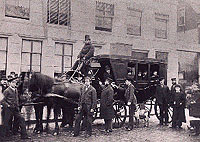|
|
Migration in the province of Utrecht (MUT/ASG)

|
Diligence to Gorinchem, Utrecht, 1883. (Coll: IISG, Amsterdam)
|
Starting in September 1993, the N.W. Posthumus Institute has supported Jan Kok in doing research using data from the Utrecht sample. This study describes migration patterns of the Utrecht population in the 19th and 20th centuries (MUT).
Migrational behaviour is, on the one hand, related to patterns in individual life careers and, on the other hand, to changes in the labour market. This study describes all migrations of all the people in the sample born between 1812 and 1912. These migrations can be described by frequency per individual, distance and direction, type (e.g. from village to city) and the frequency of return migration. Do these patterns differ when examined by sex, birth cohort, region of birth, period, occupation of the sample person's father, occupation of the sampled person, migration history of parents and/or sampled persons, etc.?
Through an NWO-supported project involving three other researchers (dr. A. Knotter, dr. R. Paping and dr. E. Vanhautte, NWO file number N14-96) the MUT-project was connected to the 'Families' labour strategies' project (ASG). This is a comparative research project using data originating from four data sets, the HSN Utrecht sample being one of them.
The first results of this research appeared in the article 'Komen en gaan. Migratiepatronen in de provincie Utrecht' in De levensloop van de Utrechtse bevolking. Results were presented at the European Social Science History Conference in Noordwijk (1996) and the Social Science History Conference in New Orleans. In March 1997 dr. J. Kok gave a lecture in Barcelona on 'Family strategies behind leaving home and youth migration, the Netherlands, 1850-1940'.
Publications
- H. Delger & J. Kok, 'Bridegrooms and biases. A critical look at the study of intergenerational mobility on the basis of marriage certificates, Historical Methods.
- J. Kok, 'Youth labour migration and its family setting, the Netherlands 1850-1940', History of the Family. An International Quarterly 2 (1997) 4.
- J. Kok, 'Komen en gaan. Migratiepatronen in de provincie Utrecht', in: Mandemakers & O. Boonstra (red.), De levensloop van de Utrechtse bevolking in de 19e eeuw (Assen: Van Gorcum 1995), 128-156.
- J. Kok, A. Knotter, R. Papaing en E. Vanhaute, Levensloop en levenslot. Arbeidsstrategieën in de negentiende en twintigste eeuw (Groningen/Wageningen 1999).
- 'Youth Labour Migration and its family setting, the Netherlands, 1850-1940' by Jan Kok. This article appeared in: History of the Family. An International Quarterly 2 (1997) 4. The article is based on the reconstructed life courses of about 1500 adolescent men and women, born between 1833 and 1912 in a Dutch province. The incidence of youth migration is charted by sex, birth period and birthplace. The influence of the family on the decision to migrate is analyzed with event history techniques. The results are evaluated in the context of regional customs related to the process of leaving home. A large number of persons, between 30% and 55% of all unmarried youths, participated in youth migration. However, family strategies were more directed towards restraining children from migration than towards stimulating them to move.
- In 2002, Jan Kok used the data of the Utrecht sample in two comparing articles published in Annales de Démograpie Historique.
- In 2003 at the 28th Social Science History Conference in Baltimore, Jan Kok and Jan van Bavel presented their results in a paper called 'The role of religion in the Dutch marital fertility transition. Starting, spacing and stopping in the heart of the Netherlands, 1845-1945'.
Top
|
|

